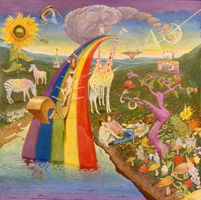|
With the publication of Aldous Huxley’s The Doors of Perception and Heaven and Hell, and of R. C. Zaehner’s Mysticism, Sacred and Profane, attention has again been given to the similarities between certain kinds of drug-induced experiences and mystical experiences. The student of world religions has long known of the sacramental use of such special agents as alcohol, plants, mushrooms, etc., to facilitate contact with the gods or make available spiritual knowledge or powers—as in the ancient Aryan use of soma and the still-practiced peyote sacrament of certain North American Indians. In spite of a long recognition of the use of such agents to facilitate or produce states of consciousness considered to be of the highest religious significance, psychologists of reliion have given very little attention to the phenomena involved. Even psychologists in general had until recently studied very little the patterns and significance of a wide range of drug-induced states of consciousness. The last fifteen years have brought a tremendous increase in psychiatric and psychological research in drug experiences. But psychologists of religion have as yet shown relatively little concern with some of the very interesting aspects of these practices which might help shed light on certain varieties of religious experience.

After a brief introduction to the known physical effects of hallucinogenic drugs—principally, LSD-25 or, more simply, LSD—this article summarizes the characteristics of a variety of drug-induced experiences. These experiences are then confronted with various types of mystical experiences which in the author’s opinion are of the same nature. In the course of the comparative confrontation several suggestions are made regarding the value of hallucinogenic drugs as potential aids to psychological studies of religion. The general standpoint of the article is that of the history and psychology of religions.
In addition to data from others’ reports—historical and experimental—the writer has been able to draw on his own experiences as a voluntary, normal subject in experimentations with lysergic acid diethylamide (LSD).
Of the recently studied drugs which often facilitate mystical-like experiences the most accessible and most used has been LSD, and perhaps secondarily, mescaline.2 The latter appears naturally in the peyote plant but can be synthetically produced.
LSD is derived from a fungus which sometimes develops in rye.
It is far less expensive to use and far more powerful than mescaline. Four to five thousand times as much mescaline as LSD is required to obtain similar effects in a subject. Generally speaking, the effects are very similar in similar subjects. As one researcher expressed it to me, psychologically there seems to be more similarity between the mescaline experience(s) and the LSD experience(s) of one subject who has had both than between the experiences of several subjects all of whom have had only one of the drugs.3 An excellent account of both somatic and typical psychological effects associated with LSD is given by Oscar Janiger.4 The following summary draws on Janiger’s article and several other published sources as well as conversations and personal experiences. Most of the effects we shall be concerned with may be described, phenomenologically, as “psychological,” i.e., they are accessible to us chiefly through the subject’s own descriptions. But first a few observations about certain physical effects of the drug are in order.
The exact nature of LSD’s biochemical influence is not yet known with certainty, but it is clear that neither that drug nor mescaline is addicting in the sense that usage makes the user physically dependent on it. And so far the evidence indicates a high probability against psychological dependence. At the time of usage, however, there are typical physiological effects which include marked changes in autonomic responses such as sweating, salivation, respiration, pulse, blood pressure, body temperature, and pupillary and vasomotor functions. These changes begin about half an hour after the drug has been taken orally and tend to persist through the height of the drug’s effects. Peak effects usually occur three to four hours after oral ingestion, but certain effects of a “psychological” nature may continue through a period of eight to ten hours or even longer. It is interesting to note that according to Janiger, “the initial degree of autonomic involvement does not seem to offer any clue as to the intensity or nature of the on-coming psychological reaction.”
The psychological reactions are of primary interest for the present study.
In the following paragraphs summaries are given of experiences reported by normal LSD subjects. These are composite descriptions taken from many different sessions and subjects.
Probably no single subject will have experienced all the varieties, certainly not in one session. The more experiments a subject has participated in, the more varied his experiences are likely to be. For example, a friend of the author who is very skillful with verbal descriptions thought that on the basis of his first two or three LSD sessions he could map and describe fairly accurately what was going on. Subsequent experiences opened entirely different vistas for him which language seemed far less adequate to describe.
“LSD and Mystical Experiences” by G. Ray Jordan, Jr. is an extract from The Highest State of Consciousness edited by John W. White, published by White Crow Books and available from Amazon and other bookstores.
Paperback Kindle
www.whitecrowbooks.com/the highest state of consciousness
|